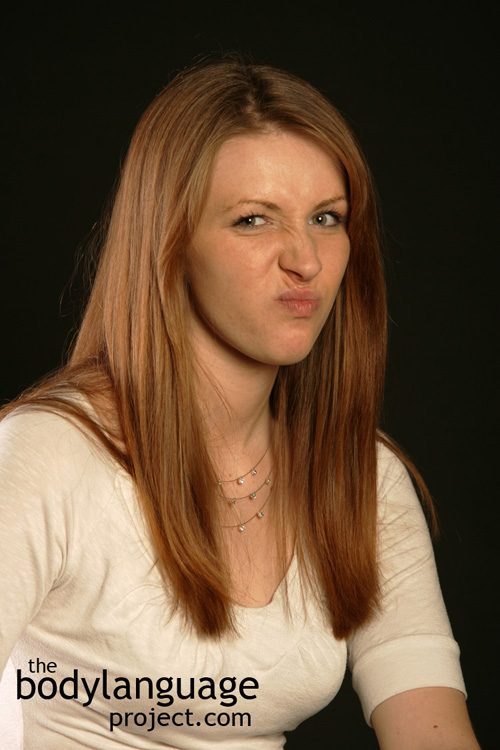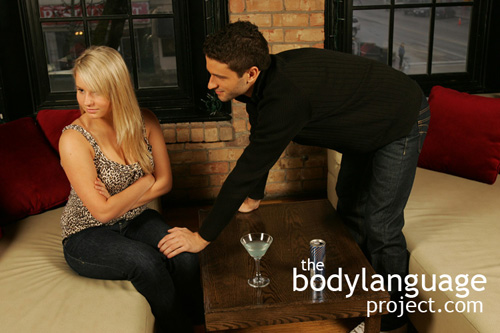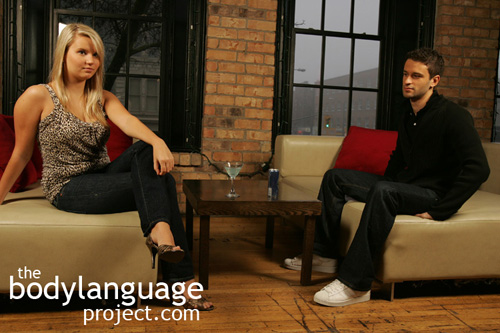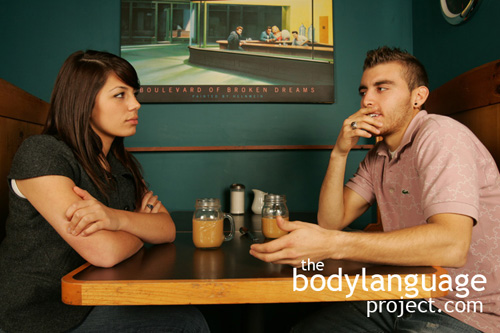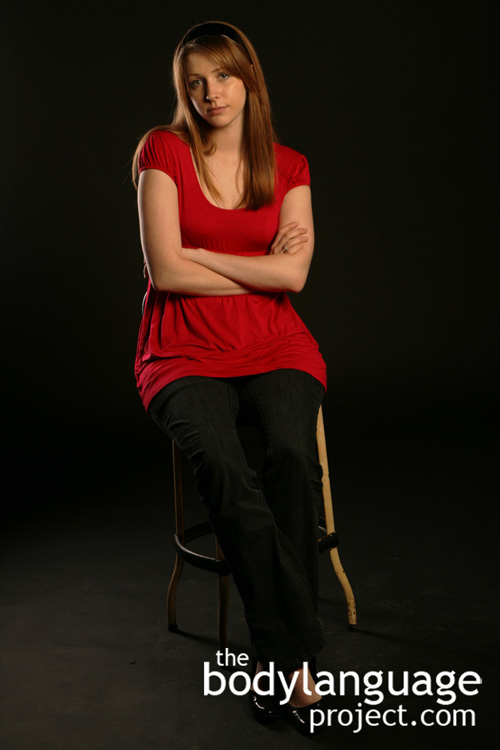Body Language of Eye Aversion, Gaze Avoidance and Wandering Eyes
 Cue: Eye Aversion and Wandering Eyes
Cue: Eye Aversion and Wandering Eyes
Synonym(s): Eye Avoidance, Eye Withdrawal, Gaze Avoidance, Averting Eyes, Roving Eyes.
Description: When eyes avoid making contact with other eyes on purpose.
In One Sentence: Avoiding eye contact signals that a person wants to avoid being called upon or that they want to create an air of superiority.
How To Use it: Eye contact can be powerful especially when it is avoided. You can show your disdain for someone by simply ignoring their presence on purpose. Likewise, avoiding eye contact can have the effect of making you disappear as well. For example, if you want to avoid being called upon by the teacher or your boss, simply avert your eyes. This tells them that you’re not prepared to interact with them and nonverbally suggests that they move along and pick on someone else.
In a dating context, women should avoid eye contact with potential suitors they do not find agreeable. Even a small amount of eye contact can be seen to be an invitation to solicit especially when combined with a smile. Thus, if possible, keep eyes only for the types of men you wish would approach. This isn’t to say, however, that women should be unfriendly, but women should realize that with friendliness, comes the responsibility of having to acknowledge and interact. If you (accidentally) make eye contact, follow through with a polite verbal decline. Here is an example: “Hi, I’m sorry, I have to leave, I’m supposed to meet with someone.”
Context: General.
Verbal Translation: a) “I don’t want to cause any more problems for myself so I’m going to avoid making eye contact with other more dominant people so I don’t draw attention and provoke people into attacking.” b) “I’m superior to you and so I’m withdrawing my eye contact and affection, and pretending you are an object not worthy of my attention or acknowledgment.”
Variant: Many other variants in eye language exist. See Eye Language category.
Cue In Action: a) The pupil didn’t want to draw any more attention to himself after throwing the paper air plane so he ducked his head down and averted his eyes in shame. His teacher knew that he was embarrassed for what he had done so she went easier on him. b) They went to bed angry at each other and instead of talking it out the next morning; they avoided each other – pretending that they didn’t exist. c) The seducer had eyes for her, but she wasn’t game. Instead of acknowledging him, she chose to avert her eyes by looking at the ground instead.
Meaning and/or Motivation: The general meaning of eyes avoiding is to show submission or discomfort. Averting the eyes has two primary purposes. One is to avoid conflict and other to power play. Eye avoidance might mean defensiveness, submission, defeat, or negative feelings. It may be done to tease and allure.
People who avert their eyes might also do so because of uncomfortable feelings such as sadness, shame or embarrassment.
Eye aversion is used to prevent others from resorting to an attack response and prevents others from seeing us as a threat. Subordinates commonly avoid eye contact with dominant individuals to indicate submission and respect. Eyes might wander to avoid being reprimanded. Eyes that avoid can serve to “flee” from an encounter, a protective response, as a person subconsciously tries to make distance between himself and his aggressor.
This is the case even if an argument is minor – the eyes will withdraw first showing that a person does not wish to pursue the debate. Eyes can also avoid eye contact thus demonstrating submission. For example, a pupil will look away from his teacher to avoid reprimand. As such, avoidant eyes can be used to reduce conflict, and at the same time, search for possible escape routes to vacate the threat.
Alternatively, eyes can show other people that they aren’t worthy of being acknowledged. We see this when people act passive aggressive. They will avoid eye contact with another person at all costs. When women walk down the street, they will purposely avoid eye contact with men so as to avoid initiating conversation, and their nonverbal message says “I don’t see you as a person worthy of my gaze, so don’t bother me.”
Other times eye contact withdrawal is a way to tease and play such as the peek-a-boo game where the absence of eye contact is part of the allure and so is a signal of interest.
Cue Cluster: When eye aversion is linked to negative thoughts it will be coupled with head dropping, shoulders turned inward and down, cowering, slouching, arm withdrawal and other protective and shrinking body language
During a power play we will see signs of both dominance and apathy. For example, a person might ignore personal space by brushing up against the other person or bumping into them, orient their bodies away, talk over or around them. Likewise, they may purposely show affection to someone else thereby creating discomfort in another.
Body Language Category: Appease, Arrogance or arrogant body language, Anger, Authoritative body language, Body size reduction, Courtship displays, Closed body language, Defensive, Disengagement, Dislike (nonverbal), Distancing or moving away, Embarrassment (nonverbal), Escape movements, Eye Language, Fearful body language, Indicators of sexual interest (IOsI), Nervous body language, Negative body language, Nonthreatening body language, Power play, Rejection body language, Readiness to submit postures, Shy nonverbal, Submissive body language.
Resources:
Argyle, Michael; Lefebvre, Luc; Cook, Mark 1974. The meaning of five patterns of gaze. European Journal of Social Psychology. 4(2): 125-136.
Argyle, M., and Ingham, R. 1972. Gaze, mutual gaze, and proximity. Semiotica, 1, 32–49.
Argyle, M. and Cook, M. Gaze and Mutual Gaze. London: Cambridge University Press, 1976.
Allan Mazur; Eugene Rosa; Mark Faupel; Joshua Heller; Russell Leen; Blake Thurman. Physiological Aspects of Communication Via Mutual Gaze. The American Journal of Sociology. 1980; 86(1): 50-74.
Aguinis, Herman ; Simonsen, Melissam. ; Pierce, Charlesa. Effects of Nonverbal Behavior on Perceptions of Power Bases. The Journal of Social Psychology. 1998. 138(4): 455-469.
Aguinis, Herman ; Henle, Christinea. Effects of Nonverbal Behavior on Perceptions of a Female Employee’s Power Bases. The Journal of Social Psychology. 2001 141(4): 537-549.
Beausoleil, Ngaio J. ; Stafford, Kevin J. ; Mellor, David J. Burghardt, Gordon M. (editor). Does Direct Human Eye Contact Function as a Warning Cue for Domestic Sheep (Ovis aries)? Journal of Comparative Psychology. 2006. 120(3): 269-279.
Baxter, James C., and Richard M. Rozelle (1975). “Nonverbal Expression as a Function of Crowding During a Simulated Police-Citizen Encounter.” In Journal of Personality and Social Psychology (Vol. 32, No. 1), pp. 40-54.
Breed, G., Christiansen, E., & Larson, D. 1972. Effect of lecturer’s gaze direction upon
teaching effectiveness. Catalog of Selected Documents in Psychology, 2: 115.
Barbato, Giuseppe ; De Padova, Vittoria ; Paolillo, Antonella Raffaella ; Arpaia, Laura ; Russo, Eleonora ; Ficca, Gianluca. Increased spontaneous eye blink rate following prolonged wakefulness. Physiology & Behavior. 2007. 90(1): 151-154.
Chen, Yi-Chia ; Yeh, Su-Ling. Look into my eyes and I will see you: Unconscious processing of human gaze. Consciousness and Cognition. 2012 21(4): 1703-1710.
Davis, Flora (1971). Inside Intuition: What We Know About Nonverbal Communication (San Francisco: McGraw-Hill).
Dawson, Michael E. ; Hazlett, Erin A. ; Filion, Diane L. ; Nuechterlein, Keith H. ; Schell, Anne M. Mineka, Susan (editor). Attention and Schizophrenia: Impaired Modulation of the Startle Reflex. Journal of Abnormal Psychology. 1993. 102(4): 633-641.
Drew, G. C. (1951). Variations in reflex blink-rate during visual motor tasks. Quaterly Journal of Experimental Psychology, 3, 73–88.
Ellsworth, Phoebe; Carlsmith, J Merrill. 1973. Eye contact and gaze aversion in an aggressive encounter. Journal of Personality and Social Psychology. 28(2): 280-292.
Foddy, Margaret 1978. Patterns of Gaze in Cooperative and Competitive Negotiation
Human Relations. 31(11):925-938.
Goodboy, Alan, K. and Maria Brann. Flirtation Rejection Strategies: Towards an Understanding of Communicative Disinterest in Flirting. The Quantitative Report. 2010. 15(2): 268-278.
http://bodylanguageproject.com/articles/how-to-reject-flirting-using-nonverbal-and-verbal-tactics/
Gregersen, Tammy S. Nonverbal Cues: Clues to the Detection of Foreign Language Anxiety. Foreign Language Annals. 2005. 38(3): 388-400
http://bodylanguageproject.com/articles/what-anxious-learners-can-tell-us-about-anxious-body-language-how-to-read-nonverbal-behavior/
Goldstein, R., Bauer, L. O., & Stern, J. A. (1992). Effect of task difficulty and interstimulus interval on blink parameters. International Journal of Psychophysiology, 13, 111–118.
Holland, M. K., & Tarlow, G. (1972). Blinking and mental load. Psychological Reports, 31, 119–127.
Holland, M. K., & Tarlow, G. (1975). Blinking and thinking. Psychological Reports, 41, 403–406. READ
Huang, Zhinjin ; Stanford, Matthew S. ; Barratt, Ernest S.. Blink rate related to impulsiveness and task demands during performance of event-related potential tasks.
Personality and Individual Differences. 1994. 16(4): 645-648.
Kampe, K.K.W. ; Frith, C.D. ; Dolan, R.J. ; Frith, U. Direct eye contact with attractive faces activates brain areas associated with ‘reward’ and ‘reward expectation’ Neuroimage. 2001. 13(6): 425-425.
Karson, Craig N. ; Berman, Karen Faith ; Donnelly, Edward F. ; Mendelson, Wallace B. ; Kleinman, Joel E. ; Wyatt, Richard Jed. Speaking, thinking, and blinking Psychiatry Research. 1981. 5(3): 243-246.
Katza, Carmit; Irit Hershkowitz; Lindsay C. Malloya; Michael E. Lamba; Armita Atabakia and Sabine Spindlera. Non-Verbal Behavior of Children Who Disclose or do not Disclose Child Abuse in Investigative Interviews. Child Abuse & Neglect. 2012. 36: 12-20.
http://bodylanguageproject.com/articles/reading-nonverbal-behaviour-child-abuse-cases-encourage-children-divulge-information-truth-telling
Kellerman. 1989. Looking and loving: The effects of mutual gaze on feelings of romantic love. Journal of Research in Personality. 23(2): 145-161.
Kendon, A. Some Functions of Gaze Direction in Social Interaction. Acta Psychologica. 1967. 32: 1-25.
Kleinke, C. L. 1980. Interaction between gaze and legitimacy of request on compliance in a field setting. Journal of Nonverbal Behavior 5(1): 3-12.
Langer, Julia and Rodebaugh, Thomas. Social Anxiety and Gaze Avoidance: Averting Gaze but not Anxiety. Cognitive Therapy and Research, 2013, Vol.37(6): 1110-1120.
Leeb. 2004. Here’s Looking at You, Kid! A Longitudinal Study of Perceived Gender Differences in Mutual Gaze Behavior in Young Infants Source: Sex Roles. 50(1-2): 1-14.
Leal, Sharon ; Vrij, Aldert. Blinking During and After Lying. Journal of Nonverbal Behavior. 2008. 32(4): 187-194.
McAndrew. 1986. Arousal seeking and the maintenance of mutual gaze in same and mixed sex dyads Source: Journal of nonverbal behavior. 10(3):168-172.
Mulac, A., Studley, L., Wiemann, J., & Bradac, J. 1987. Male/female gaze in same-sex
and mixed-sex dyads. Human Communication Research. 13: 323-343.
Natale, Michael. 1976. A Markovian model of adult gaze behavior. Journal of Psycholinguistic Research. 5(1): 53-63.
Navarro, Joe. 2008. What Every BODY is Saying: An Ex-FBI Agent’s Guide to Speed-Reading People. William Morrow Paperbacks.
Phelps, F., Doherty-Sneddon, G., & Warnock Educational Psychology., 27, 91-107. (2006). Functional benefits of children’s gaze aversion during questioning. British Journal Developmental Psychology. 24: 577-588.
Rosenfeld, H., Breck, B., Smith, S., & Kehoe, S. 1984. Intimacy-mediators of the proximity-gaze compensation effect: Movement, conversational role, acquaintance, and gender. Journal of Nonverbal Behavior. 8: 235-249.
Rule, Nicholas, O.; Reginald B. Adams Jr.; Nalini Ambady and Jonathan B. Freeman. Perceptions Of Dominance Following Glimpses Of Faces And Bodies. Perception. 2012; 41: 687-706 doi:10.1068/p7023
http://bodylanguageproject.com/articles/people-can-read-dominance-split-second
Stern, Daniel and Estelle Bender (1974). “An Ethological Study of Children Approaching a Strange Adult.” In Richard Friedman et al. (Eds.), Sex Differences in Behavior (New York: John Wiley and Sons), pp. 233-58.
Sturman, Edward D. Invluntary Subordination and Its Relation to Personality, Mood,
and Submissive Behavior. Psychological Assessment. 2011. 23(1): 262-276 DOI: 10.1037/a0021499
http://bodylanguageproject.com/articles/nonverbal-submission-men-women-depression-critical-examination-use-disuse-submission/
Siegle, Greg J ; Ichikawa, Naho ; Steinhauer, Stuart. Blink before and after you think: blinks occur prior to and following cognitive load indexed by pupillary responses.
Psychophysiology. 2008. 45(5): 679-87.
Strick, Madelijn ; Holland, Rob W. ; Van Knippenberg, Ad. Seductive Eyes: Attractiveness and Direct Gaze Increase Desire for Associated Objects Cognition. 2008. 106(3): 1487-1496.
Williams. 1993. Effects of Mutual Gaze and Touch on Attraction, Mood, and Cardiovascular Reactivity Source: Journal of Research in Personality. 27(2): 170-183.
Weisfeld, Glenn E. and Jody M. Beresford. Erectness of Posture as an Indicator of Dominance or Success in Humans. Motivation and Emotion. 1982. 6(2): 113-130.
http://bodylanguageproject.com/articles/body-language-cues-dominance-submission-children/
Wirth, James H ; Sacco, Donald F ; Hugenberg, Kurt ; Williams, Kipling D. Eye gaze as relational evaluation: averted eye gaze leads to feelings of ostracism and relational devaluation. Personality & social psychology bulletin. 2010 36(7): 869-82.
Wang, Yin ; Newport, Roger ; Hamilton, Antonia F De C. Eye contact enhances mimicry of intransitive hand movements. Biology letters. 2011. 7(1): 7-10.

